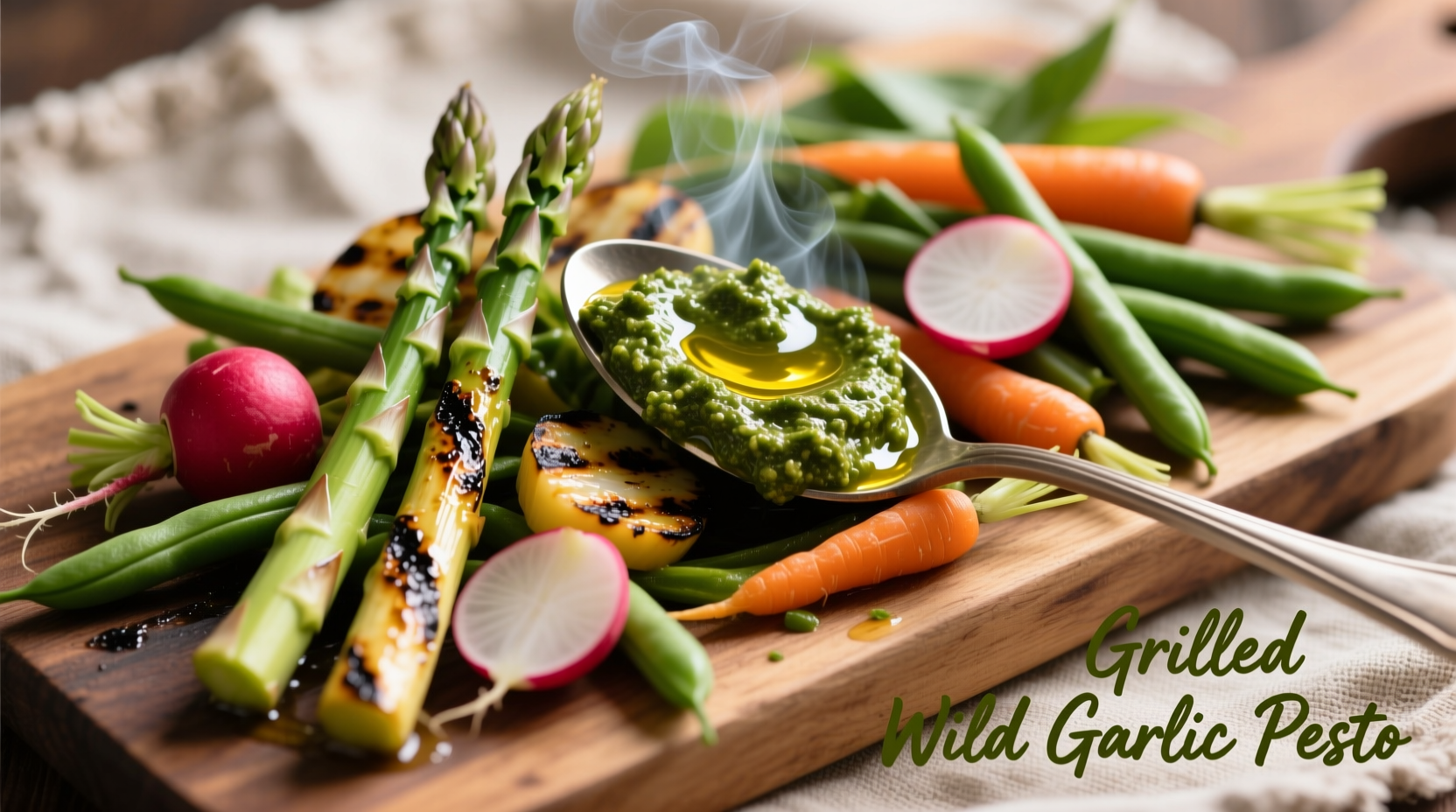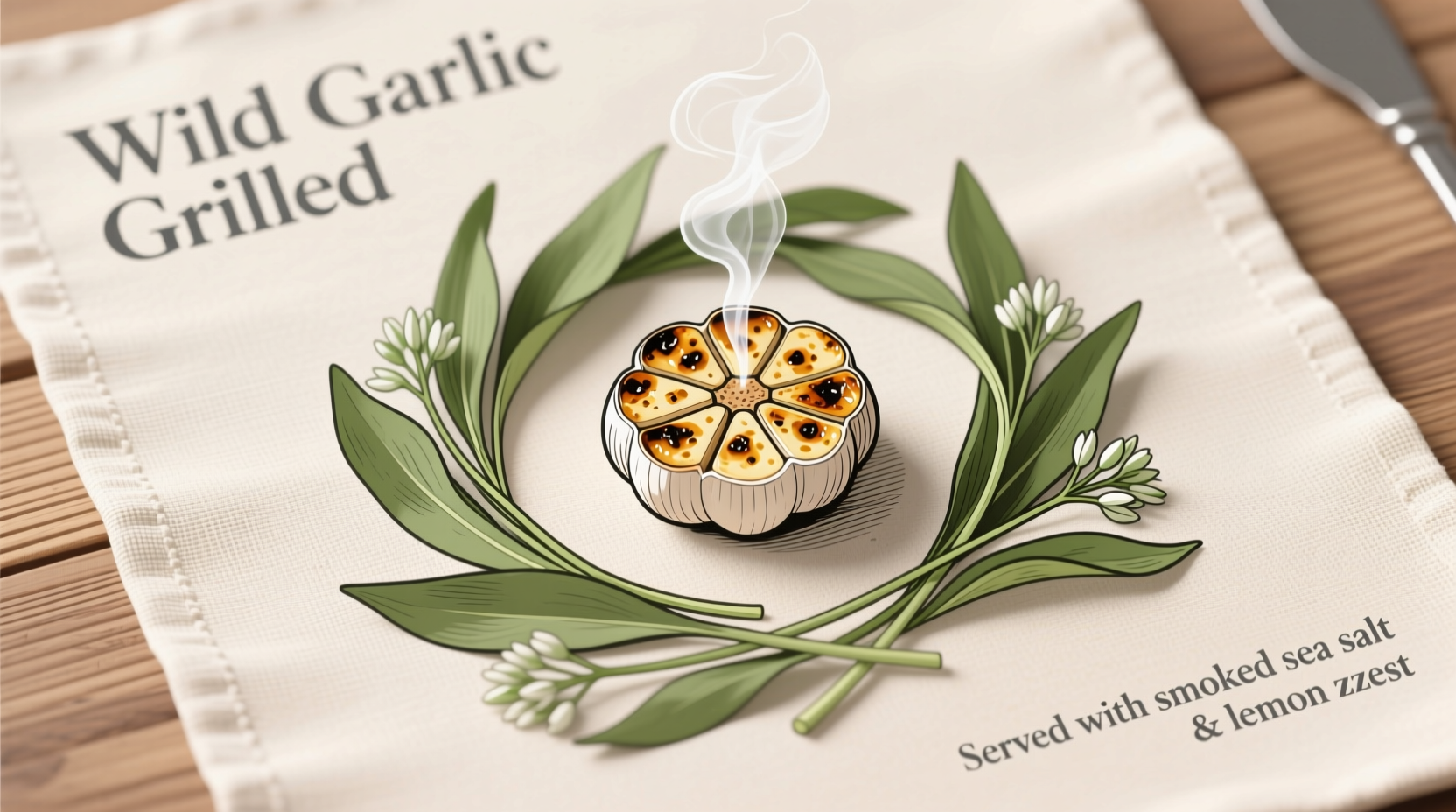As the first green shoots emerge through forest floors each spring, wild garlic signals the beginning of a brief but cherished culinary season. This foraged ingredient, known as ramsons or bear's garlic, offers a milder, more complex flavor than cultivated garlic with distinctive grassy notes that pair exceptionally well with grilled foods. Understanding how to incorporate this ephemeral ingredient into your grilling repertoire can transform ordinary dishes into seasonal celebrations.
Why Wild Garlic Elevates Grilled Dishes
Wild garlic's unique chemical composition changes when exposed to heat, creating flavor compounds that complement grilled foods in ways cultivated garlic cannot match. When grilled, wild garlic develops subtle sweetness while maintaining its characteristic aroma without becoming harsh or bitter. Food scientists at the University of Copenhagen have documented how the allicin compounds in wild garlic break down differently under heat compared to regular garlic, producing more complex flavor notes that enhance rather than overpower grilled meats and vegetables.
Unlike its cultivated cousin, wild garlic contains higher concentrations of natural sugars that caramelize beautifully on the grill. This makes it particularly valuable for creating nuanced flavor profiles in spring menus when other fresh greens are still scarce.
| Wild Garlic Characteristic | Impact on Grilled Dishes | Best Application Method |
|---|---|---|
| Milder sulfur compounds | Less pungent after grilling | Whole leaf grilling or as garnish |
| Higher natural sugar content | Better caramelization | Infused oils for basting |
| Delicate leaf structure | Quick wilting without charring | Added in final cooking minutes |
| Seasonal availability (Apr-Jun) | Creates menu urgency and exclusivity | Feature as limited-time offerings |
Building a Seasonal Wild Garlic Grill Menu
Creating a cohesive wild garlic grill menu requires understanding both the ingredient's limitations and its transformative potential. Professional chefs typically structure their wild garlic offerings across multiple menu categories to maximize the ingredient's versatility while respecting its delicate nature.
Appetizers That Showcase Freshness
Start with preparations that highlight wild garlic's raw qualities before heat transforms its flavor profile. Wild garlic pesto served with grilled sourdough crostini allows diners to experience the pure, unadulterated flavor. The Royal Horticultural Society notes that wild garlic contains 30% more vitamin C than cultivated varieties, making raw applications particularly valuable nutritionally.
For grilled applications, wrap wild garlic leaves around soft cheeses like goat cheese or burrata before brief grilling. The leaves protect the cheese while infusing it with subtle garlic notes. This technique appears on spring menus at Michelin-recognized restaurants across Europe, particularly in the UK and Germany where wild garlic grows abundantly.

Main Course Applications
When incorporating wild garlic into main courses, timing is critical. Add wild garlic during the final minutes of grilling to preserve its delicate flavor. For meats, create compound butters with finely chopped wild garlic and let them melt over grilled proteins just before serving. This technique appears consistently in professional kitchen guides from the Culinary Institute of America as the optimal method for preserving volatile flavor compounds.
For fish and seafood, weave wild garlic leaves between scallops or wrap them around salmon fillets before grilling. The leaves create a natural barrier that prevents overcooking while imparting flavor. Vegetarian options shine when wild garlic is incorporated into grilled vegetable skewers or folded into mushroom caps before grilling.
Sauces and Condiments That Extend Flavor
Since wild garlic's season is brief, professional kitchens often create infused oils or vinegars at the beginning of the season to extend its usability throughout spring menus. The University of Reading's Centre for Food Studies recommends cold-infusion methods for preserving wild garlic's delicate flavor compounds without the bitterness that heat extraction can cause.
Wild garlic aioli serves as a versatile condiment that bridges multiple menu sections. Unlike traditional garlic aioli, wild garlic versions maintain a brighter, more complex flavor that complements grilled dishes without overwhelming them. Many high-end restaurants now feature wild garlic-infused mayonnaise as a standard spring offering.
Practical Implementation Guide
Successfully incorporating wild garlic into your grill menu requires attention to sourcing, preparation, and timing. Unlike cultivated garlic, wild garlic has specific handling requirements that affect its performance on the grill.
Sourcing and Identification
Proper identification is crucial as wild garlic has toxic look-alikes like lily of the valley and autumn crocus. The Woodland Trust, a UK conservation charity, emphasizes that wild garlic can be safely identified by its distinctive garlic scent when leaves are crushed, white star-shaped flowers, and growth pattern in woodland areas near streams. Never harvest from areas potentially contaminated by pesticides or heavy metals.
Preparation Techniques for Grilling
Wash wild garlic gently in cold water and dry thoroughly before use. Excess moisture causes steaming rather than proper grilling. For best results, chop wild garlic just before adding to dishes to prevent oxidation. When creating infused oils for basting, use a 3:1 oil-to-wild-garlic ratio and allow 24 hours for flavor development at room temperature before straining.
Flavor Pairing Principles
Wild garlic's delicate flavor works best with complementary spring ingredients. Professional chefs consistently pair it with:
- Lemon zest and juice to brighten its grassy notes
- New potatoes and spring vegetables that share its earthy qualities
- Fresh herbs like chives and parsley that enhance rather than compete
- Mild cheeses that provide creamy contrast to its slight sharpness
Avoid pairing wild garlic with strongly flavored ingredients like smoked paprika or aged cheeses that would overwhelm its subtle profile. The seasonal nature of wild garlic creates natural menu urgency—highlight this limited availability in your descriptions to enhance customer interest.
Seasonal Menu Planning Timeline
Understanding wild garlic's growth cycle helps create a strategic menu rollout. The University of Bristol's Botanical Gardens tracks wild garlic availability through three distinct phases:
| Seasonal Phase | Characteristics | Recommended Menu Applications |
|---|---|---|
| Early Season (April) | Tender young leaves, mild flavor | Raw applications, delicate sauces, garnishes |
| Peak Season (May) | Full flavor development, flower buds appear | Grilled preparations, compound butters, pestos |
| Late Season (Early June) | Flowers fully bloomed, leaves coarser | Infused oils, vinegars, pickled applications |
As wild garlic season concludes, transition smoothly to other seasonal ingredients by featuring dishes that incorporate both wild garlic and emerging summer herbs. This creates menu continuity while respecting the ingredient's natural lifecycle.
Avoiding Common Pitfalls
Many home cooks and restaurants make critical errors when working with wild garlic that diminish its special qualities. Food safety experts at the European Food Safety Authority warn against:
- Overcooking, which destroys delicate flavor compounds
- Using dried wild garlic (loses most flavor and nutritional value)
- Confusing it with toxic look-alikes during foraging
- Storing improperly (wilts within 2-3 days even refrigerated)
For optimal results, use wild garlic within 48 hours of harvesting and add it during the final stages of cooking. When creating wild garlic grill menus, clearly communicate the seasonal nature of the ingredient to set proper customer expectations about availability.











 浙公网安备
33010002000092号
浙公网安备
33010002000092号 浙B2-20120091-4
浙B2-20120091-4